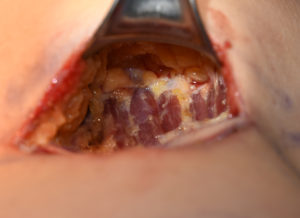Synthetic implants are the original method of buttock augmentation. While supplanted in numbers by the Brazilian Butt Lift (fat injections), buttock implants are still a good option for the properly selected patient. Implants offer assured permanent buttock augmentation and are the only option for those patients who have inadequate fat stores for liposuction harvest.
Buttock implants have an undeserved reputation of a high incidence of postoperative complications. If put in by an inexperience surgeon, a very large implant is placed or a purely subcutaneous implant position is used, complications will likely ensure. But a properly sized implant (350cc or less) placed in an intramuscular position is associated with a lower risk of potential complications.

But does the intramuscular technique with the pressure of an implant cause any long-term problems? This was the intent of a study published in the February 2013 issue of the journal Plastic and Reconstructive Surgery entitled ‘ Intramuscular Technique for Gluteal Augmentation: Determination and Quantification of Muscle Atrophy and Implant Position by Computed Tomogtraphic Scan’. Twenty-three women who had buttock implants of either a round or oval base were studied by computed tomogtraphic (CT) scans to determine implant position and the degree of muscle atrophy by using CT scans done before and at 3, 6 and 12 months after surgery. All patients showed some muscle atrophy which ranged from 2 to 5% on either muscle side. All oval implants had rotated from a vertical orientation to an oblique direction.
These study results convincely show that the intramuscular technique results in a minimum of muscle atrophy with no physical sequelae as a result. All buttock implants stayed within the created pocket without displacement or migration.
While the intramuscular implant technique does have more of a recovery and is harder to technically do, it is a very safe technique that produces good long-term buttock augmentation results.
Dr. Barry Eppley
Indianapolis, Indiana


